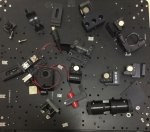My goal is to build a michelson morley interferometer to demonstrate destructive interference where the detector is black. I have seen many videos where they show rings. I would like it to go all dark or close to it. A good demonstration is this youtube video.
I have a laser table with these vibration absorbers
https://www.shopbdproduct.com/product_p/s64-aa-12.5.htm
I have this laser : coherent vmb2.3-15L 10.5 mw 635 nm. Will this laser work and does anyone know the power supply or a battery that can run it.
I have various mirrors, beamsplitters, and an beam expander. If anyone has any tips they would be appreciated. I am new to lasers.
I have a laser table with these vibration absorbers
https://www.shopbdproduct.com/product_p/s64-aa-12.5.htm
I have this laser : coherent vmb2.3-15L 10.5 mw 635 nm. Will this laser work and does anyone know the power supply or a battery that can run it.
I have various mirrors, beamsplitters, and an beam expander. If anyone has any tips they would be appreciated. I am new to lasers.









